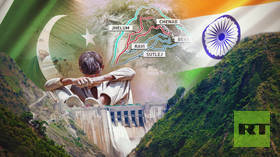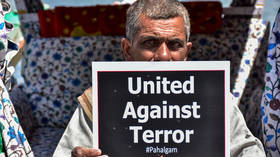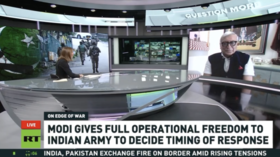Kashmiri border residents shattered by night shelling from Pakistan — RT India

The ongoing escalation between the two nuclear-armed neighbors is one of the deadliest in recent years, particularly for ordinary people
In the serene village of Mendhar, nestled in the mountains of Poonch district in the southern region of Jammu close to the Line of Control (LoC), a quasi-border between India and Pakistan, the night of tranquility on Wednesday was shattered by intense shelling from across the border. At least 16 civilians, including women and children, were killed and 44 people were wounded.
The residents recalled it as the worst shelling in decades. They woke up to the deafening sounds of shellfire as Pakistani artillery targeted civilian areas along the LOC in multiple locations across Jammu and Kashmir. “This was a night of grief and terror.”
We did not know what to do as shells were landing everywhere on houses, killing small children, triggering fire,” said Sukhchain Singh, a farmer, whose two neighbors, Amreek Singh, 55, and Ranjit Singh, 48, both shopkeepers, were killed in the shelling. ”We are in grief and mourning, and now we also fear for our lives,” he said.
Analysts have called the assault one of the deadliest in recent years. It was in response to India’s ‘Operation Sindoor’ launched on the night of May 7 and targeting terrorist infrastructure in Pakistan in retaliation for a deadly terrorist attack in Pahalgram, Kashmir in April.
Tensions between India and Pakistan have sharply escalated following the attack that left 26 people dead. India, which has long accused Pakistan of aiding militant infiltrations in Kashmir, has signaled that it holds Pakistan responsible – a claim Pakistan denied. The two neighbors have fought several wars since their independence from Britain in 1947 as they both claim Jammu and Kashmir in its entirety.
“We have not seen anything like this in years, though we have been living in the border area for decades now. This was a doomsday. It is the innocent civilians who get caught in the fire; how were the small children to blame who were killed?” said Tahira Bano, another resident who along with her family of five was evacuated to a government school in Poonch town.
‘Like a war zone’
Poonch town was the worst affected, where locals said that the shelling continued for six hours, sparking fear and terror among residents who were caught unaware. The tension between India and Pakistan had been building for days after the Pahalgam attack, in which 26 tourists were killed by terrorists. India has blamed Pakistan, although Pakistan has denied the charge.
In retaliation for the Pahalgam attack, India launched ‘Operation Sindoor’, which New Delhi said targeted nine “terror bases” in Pakistan.
However, Islamabad retorted that 31 civilians were killed in an Indian strike and the attack would be avenged, which has heightened the tensions between the two countries. World leaders have meanwhile appealed for calm between the two nuclear-armed neighbors.
Ajaz Jan, a local legislator, said that the entire town in Poonch had been affected by the heavy shelling from across the border. “This was like a war zone,” he said.
The videos shared by the locals with RT show a house turned into ruins, dead bodies of children being carried out in vans, and smoke rising high in the air. Residents have yet to recover from the scenes of chaos, with despairing families huddled in makeshift shelters, mourning the loss of loved ones and the destruction of their homes.
“This was a peaceful village, but now there is smoke everywhere,” says Abdul Salam Khatana, 55, another resident. While the Indian army says that they have responded to the ceasefire violations, the civilian population continues to bear the brunt of the escalating tensions all across the border in Jammu and Kashmir.
“We do not know what lies ahead for us. War is not an option; the innocent civilians pay the price. It takes years to build a life on the mountain, and now it has taken seconds to turn everything into ashes,” Khatana said, adding that the locals long for peace.
Hitting the most vulnerable
Mohmad Waseem Malla, a research fellow at the International Centre for Peace Studies New Delhi said that that residents along the LoC are the most vulnerable, being situated directly on the front line.

“There are already so many casualties being reported. Should tensions escalate further, these communities may face not only temporary displacement but also significant restrictions on access to their agricultural lands – an essential source of livelihood,” Malla said.
He added that at this juncture, it remains to be seen how the situation will evolve. “Nevertheless, India’s response thus far appears calibrated, aiming to establish deterrence while preventing a broader escalation.”
Michael Kugelman, the Director of the South Asia Institute at the Wilson Center, said that this time the violence is much worse than, for instance, in 2019 when India conducted precision strikes on a terrorist camp in Balakot, Pakistan, following an attack on the military convoy in Pulwama that resulted in the death of 40 personnel. Tensions now are “already higher up the escalatory ladder than any time in the ‘19 crisis,” Kugelman said.
While the borders between India and Pakistan have witnessed skirmishes for decades, the roaring guns had mostly fallen silent after the 2003 ceasefire agreement between the two countries. Experts say that the current scale of cross-border shelling has not been seen since the 1971 India-Pakistan War.
‘We want peace’
Shelling was also witnessed in the northern districts of Uri and Kupwara – two districts close to the LoC. Many civilian homes were damaged and several people were injured, including three children.
The locals have been asked to move to safety by the government. The authorities have also ordered the closure of schools and colleges in many districts of Jammu and Kashmir.
The three airports in the region – Srinagar, Jammu and Leh – have been closed until May 10. There is chaos and uncertainty among the local population, who fear that hostilities could increase and have started hoarding essentials like gasoline. RT spoke to locals in the villages of Gingal, Dachina, and Salamabad, where residents said that many houses caught fire due to the intensity of the shelling.
“The blazing fire was so intense that within seconds it spread, we found no other option but to leave our livestock behind and flee the village,” said a resident of Salamabad in Uri, who has now left his home behind and gone to a shelter in the town. “We want peace and not war. This is taking a toll on our lives, our mental health is shattered. We feel helpless,” said Irshad Ahmad, a resident of Garkote village in the same district. While the situation remains tense with fear of more escalation, Ahmad said that he hopes that hostilities will end soon. “We hope that peace comes back and we can return to our homes.”


